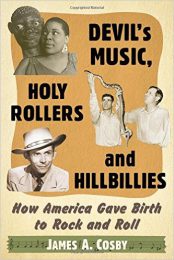What historically led to the rise of American teenage youth culture and paved the way for rock’n’roll is the subject of James Cosby’s latest book.
As examined against the subcultural background of post-war America, and the arrival of new musical impulses from African American culture, teenager’s unknown struggles for autonomy in an altogether anxious and cautious society, a colorful picture of early 1950s in the US is recreated on those pages.
 The altogether 15 texts deal with the blues, early hillbilly music, the Mississippi delta, Elvis, Chuck Berry and early rock music. The important origins that many of the important performers shared, was their vocal training as well as their fervor and energy that was learned in church and church service by both black and white artists. Pentecostalism played a huge role here, as Cosby points out when he analyses the musical styles of Sister Rosetta Tharpe, Jerry Lee Lewis, Elvis and Little Richard.
The altogether 15 texts deal with the blues, early hillbilly music, the Mississippi delta, Elvis, Chuck Berry and early rock music. The important origins that many of the important performers shared, was their vocal training as well as their fervor and energy that was learned in church and church service by both black and white artists. Pentecostalism played a huge role here, as Cosby points out when he analyses the musical styles of Sister Rosetta Tharpe, Jerry Lee Lewis, Elvis and Little Richard.
The first few chapters are actually concise and informative, but sadly, there is generally nothing new or spectacular in the later chapters when the book’s theme, American music, teenagers and the birth of rock’n’roll, comes up.
However, readers looking for a deep study on the history of rock’n’roll with reference to details, record production histories or the long stories behind certain developments in the 1950s may find more information in biographies of the respective musicians or in sociological volumes. At the same time, the title by Cosby, who is a contributor to various popular culture publications, will be useful in classroom or serve as an introduction to the vast field of musical culture of this important age for very young readers. The language and rhetoric used point to such a purpose and concise publications on the era are rare. (This review was altered in 2018.)
Review by Dr. A. Ebert © 2016
James A. Cosby. Devil’s Music, Holy Rollers and Hillbillies: How America Gave Birth to Rock and Roll. McFarland, 2016, 264 p.
